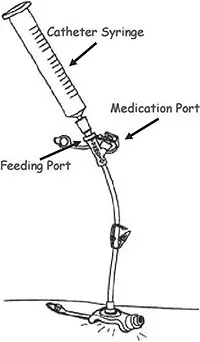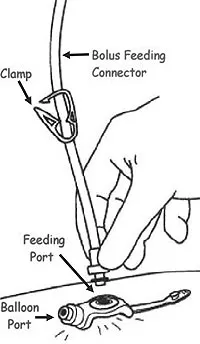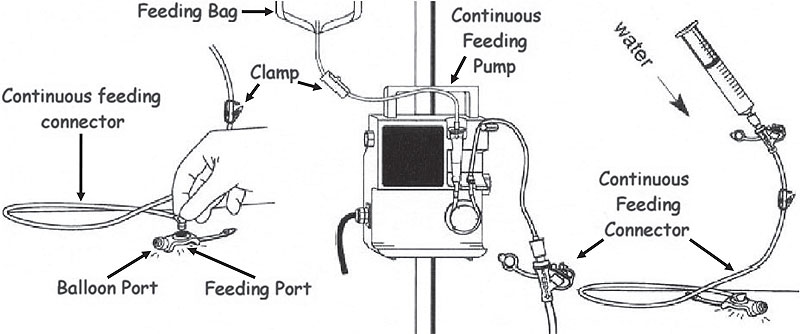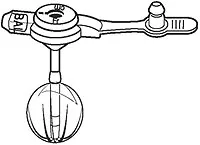Bolus feeding with a G-button
A gastrostomy button (or G-button) is used to feed your child or give medicine. Bolus feeding means giving formula over a short period of time (10 – 20 minutes). This method is also used to give medications or extra fluid.

Getting ready
- Wash hands with soap and water.
- Gather supplies (see below).
- Prepare formula or medication.
- Inspect the G-button and the skin around it.
Bolus feedings
Supplies:
- Bolus feeding connecter tube
- Large catheter syringe
To give a feeding:
- Attach the bolus feeding connector to the button and release the clamp.
- Remove the plunger from a large catheter syringe and insert tip into the connecting tube.
- Pour water into the syringe and clamp the connector tube when it is filled with water.
- Pour formula into the syringe to feed. Raise the syringe to make the formula go in faster. Lower the syringe to go slower. Keep the syringe filled with formula to decrease the amount of air that gets into the stomach.
- When done feeding, clamp the tube. Add lukewarm water to the syringe, unclamp the tube and flush with water until the tube is clear (usually 10 – 20 cc).
- Disconnect the tube. Clean the syringe and bolus connector tube with soapy water. Rinse well with warm water and air dry.
Continuous feeding with a G-button
A gastrostomy button (or G-button) is used to feed your child or give medicine. Continuous feeding means giving formula over a long period of time (8 – 24 hours). You and your provider will decide what length of time is best for your child.

Getting ready
- Wash hands with soap and water.
- Gather supplies (see below).
- Prepare formula or medication.
Continuous feedings
Supplies:
- Feeding connecter
- Pump
- Feeding bag.
To give a feeding:
- Clamp the connector tubing on the feeding bag then add formula to the bag.
- Unclamp the tube and allow the formula to fill the tubing. Reclamp when the formula reaches the feeding bag connector (you may want to do this over a sink to avoid a mess).
- Attach feeding bag connector to the feeding port on the G-button.
- Program the pump as directed. Unclamp all clamps on the tubing and start the feeding.
- When the feeding is done, disconnect the pump and flush the tubing with lukewarm water until clear.
- Disconnect the tubing from the button and replace the button cap.
- Clean the bag, tubing and connector with soapy water. Rinse well and air dry.

How to change or replace a G-button
You should always have a replacement G-button at home. If you don’t, call your home health supplier. It is often good to carry a plastic bag with an extra G-Button, syringes, and lubrication in your purse or diaper bag.
Change the G-button every four months unless there’s a reason to change it earlier (the button leaks, it’s pulled out by accident, or you need a longer one.)
If the G-button comes out, the hole gets smaller fast. Use your replacement or another tube if you’ve been given one. If you have nothing else, put the old one back in and tape it down. Call our office.
If you can’t get anything back into the stoma, call us or go to the ER. The sooner you get there, the more likely we will be able to replace a button or tube before the stoma closes.
How to replace a gastrostomy button
Supplies:
- G-button or another tube if you were given one
- A 5 or 10cc syringe
- Lubricant (Surgilube® or K-Y® jelly).
Changing a G-button:
1. Wash your hands with soap and water.
2. Prepare the replacement button:
- Fill a syringe with 5cc of water and insert it into the balloon port. The amount you should put in (usually 5cc) is often written on the button or in the instruction book. Check for leaks. Take the water back out but leave the syringe connected.
- Put lubricant jelly on the tip of the new button. Do not use petroleum jelly (like Vaseline®), oil, or lotion. The replacement button is now ready to be inserted.
3. If you need to take the old button out, you should first:
- Prepare your replacement button or tube and put it within reach.
- Make sure the old button turns easily and is not attached to the skin or stoma tissue.
- Insert an empty 5 or 10cc syringe into the balloon port and take out all the water.
4. Take the old button out (if still in) and insert the new button immediately. It helps to hold the tube between your fingers close to the bottom to keep the tube from bending. Push it all the way in and hold the button against the skin while you put water into the balloon. Keep pressure on the plunger of the syringe while disconnecting so no water leaks out of the balloon.
5. Check for correct placement (if it was easy, it’s probably in the right place):
- Attach the bolus feeding connector.
- Insert a large catheter syringe (with the plunger in place) into the feeding port.
- Pull back the plunger. If fluid comes back, you are in the right place. Flush with water.
- If you are not sure if you’re in the right place, don’t use the button.
Giving medications by the button

Small slip tip syringes are used to give medicine and flush water through the medication port.
1. Set out the correct dose of medicine to put into the button. Do not mix medication with formula or other medications unless instructed to do so by your doctor.
Liquids:
- Most liquid medicine may be given through a button.
- Draw up the exact amount of medicine into a syringe.
Pills:
- Check with your doctor or pharmacist before crushing pills—some pills should not be crushed.
- Crush the pill between two spoons (or use a pill crusher) to make a fine powder.
- Mix the powder in water and make sure it dissolves completely.
- Draw up all of the mixture into a syringe.
Capsules:
- Check with your doctor or pharmacist if it is okay to open the capsule and give through the G-botton.
- Open the capsule and mix the contents with water.
- Draw up all of the mixture into a syringe.
2. If your child is on a continuous feeding, stop the pump and disconnect the feeding bag tubing.
3. Insert a syringe with water into the medication port and flush the connector tube with water.
4. Pinch or clamp the tube. Remove the first syringe and insert the syringe with the medication. Unclamp the tube and give the medicine.
5. Add lukewarm water to the syringe and flush medication completely through the tube into the stomach.
6. If giving more than one one medication at a time, flush with lukewarm water between each medication.
7. Unless your pharmacist tells you to wait, you can restart your feeding. If you are done feeding, remove th connector tubing from the button and close the cap on the button.
8. Wash the syringes and connector tubing with warm, soapy water and allow to air dry.